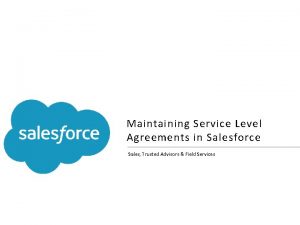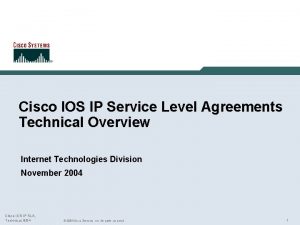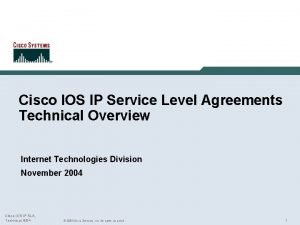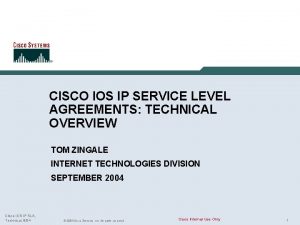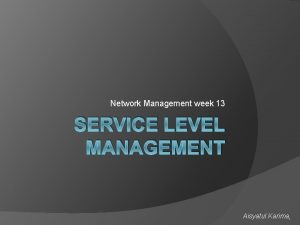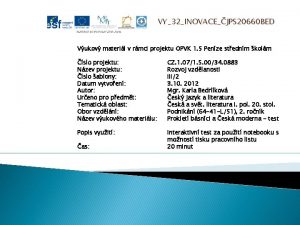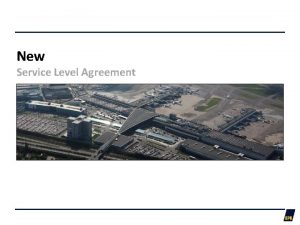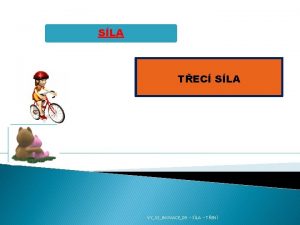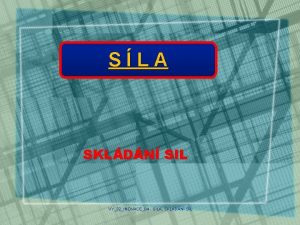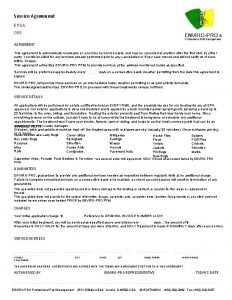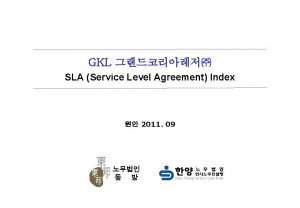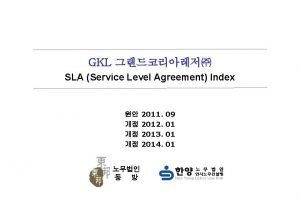Qo S Service Level Agreement SLA for TacticalDeployed














- Slides: 14

Qo. S Service Level Agreement (SLA) for Tactical/Deployed Scenario • • Deborah Goldsmith MITRE Corporation (619)758 -7829 deborah@mitre. org

Outline • • Problem Statement General Requirements Scenario Description Tactical /Deployed SLA Data Classification and Marking Issues Questions 2

Problem Statement • Meet Qo. S Service Level Agreements (SLA’s) for the Tactical/Deployed platform across the End-to-End Circuit 3

General Requirements* • Applications will converge to a common infrastructure (most likely Layer 3 IP) – – Voice Video Datagram Control/Management • Applications MUST work end-to-end across wide diversity of LANs, MANs, WANs • System MUST allow user to indicate missionbased priority and support priority handling to resolve end-to-end bottlenecks • System MUST meet stringent IA requirements * DISA, 5 -29 -02 4

Scenario Description: The End-to-End Circuit* FIXED CAMP/POST/STATION TACTICAL WIDE AREA NETWORK TACTICAL/DEPLOYED END-TO-END DISN • Solution must apply to ALL elements of the Defense Information Systems Network (C/P/S, WAN, TACTICAL) – F-F, F-T, T-T • Multiple domains – Traffic in the WAN traverses many network domains that may be considered analogous to external carrier networks with their own Qo. S/SLA’s * DISA, 5 -29 -02 5

Scenario Description: The Tactical/Deployed Segment • Tactical deployed communications use multiple RF gateways • RF gateways represent bottlenecks due to bandwidth constraints 6

Scenario Description: The Tactical Platform & the RF Gateway SLA enclave LAN WAN GW VPN LAN LOS VPN WAN GW RF GW enclave LAN 7

Tactical/Deployed SLA • • Minimum bandwidth guarantees for specified data types or sources B/W, latency, jitter guarantees for Vo. IP and packet VTC Latency guarantees for tactical messages No starvation for Best Effort (BE) (aggregate) 8

Data Classification and Marking 9

Application Flow Categories* Each category has Qo. S Performance Metrics Qo. S Application Flow Type Application Example Flow Continuous/Interactive Voice over IP, VTC TCP Setup and UDP Flow Streaming Video Imagery, Multicasting TCP Setup and UDP Flow Block Transfer Telnet, http TCP Flow Batch Transfer E-mail, ftp TCP Flow Transactional Client / Server, e-commerce TCP Flow Other SNMP, RIP, OSFP, BGP, TFTP, DHCP, ICMP Non-TCP * DISA, 5 -29 -02 10

Marking RFC’s 11

Sample DSCP Marking by Application Categories • Marking by priority and latency requirements 12

Issues • Mobility • Ad-hoc Networks • Link outage and degradation 13

Questions – Can Diff. Serv (DSCP’s) be the basis of a near-term implementation plan to implement endto-end Qo. S for the tactical/deployed scenario? Yes No • • • Bandwidth Reservation for some applications B/W, Latency and Jitter guarantees for VOIP, VTC Latency guarantees for tactical messages Priority and precedence No starvation for Best effort – What are the end-to-end Qo. S mechanisms to implement a long-term implementation plan? • • • Dynamic Qo. S based on policy Admission control Qo. S-aware applications signaling the network Reroute with Qo. S on link failure /degradation Mobility Performance monitoring and control 14
 Service level agreement salesforce
Service level agreement salesforce Cisco service level agreement
Cisco service level agreement Cisco service level agreement
Cisco service level agreement Cisco ip service level agreement
Cisco ip service level agreement Service level agreement adalah
Service level agreement adalah Service level agreement template
Service level agreement template Https://www.servicetonic.es/service-desk/que-es-un-sla/
Https://www.servicetonic.es/service-desk/que-es-un-sla/ Https://www.servicetonic.es/service-desk/que-es-un-sla/
Https://www.servicetonic.es/service-desk/que-es-un-sla/ Negative agreement
Negative agreement Microsoft services provider license agreement
Microsoft services provider license agreement Msp master service agreement
Msp master service agreement Long term service agreements
Long term service agreements Funding service agreement
Funding service agreement šla žitím matka má jak kajícnice smutná
šla žitím matka má jak kajícnice smutná Sla theory
Sla theory
